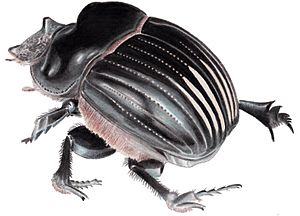Carolina copris facts for kids
Quick facts for kids Carolina copris |
|
|---|---|
 |
|
| Scientific classification | |
| Genus: |
Dichotomius
|
| Species: |
carolinus
|
The Dichotomius carolinus, also known as the Carolina copris, is a type of dung beetle found in the Scarabaeidae family. These amazing insects play a super important role in nature by helping to clean up the environment.
Contents
What is a Carolina Copris?
The Carolina copris is a specific kind of dung beetle. Dung beetles are famous for their unique habit of eating and burying animal waste, also known as dung or poop. They are part of a very large group of beetles called Scarabaeidae, which includes many different kinds of beetles, like rhinoceros beetles and flower beetles.
What Do Dung Beetles Look Like?
Most dung beetles, including the Carolina copris, are usually dark-colored, often black or dark brown. They have strong bodies and powerful legs. Their legs are especially good for digging and rolling dung balls. Some dung beetles can be quite large, while others are small.
Where Do Carolina Copris Beetles Live?
The Carolina copris is native to North America. You can find them in many parts of the United States, especially in the southeastern regions, which is why they are called "Carolina" copris. They prefer habitats where there are plenty of large animals, like cows or deer, because that's where they find their food.
What is Their Habitat Like?
These beetles live in places like pastures, forests, and grasslands. They need soil that they can dig into easily to bury dung. They are often found near farms or areas with wild animals.
What Do Dung Beetles Eat?
Dung beetles, as their name suggests, eat dung! This might sound a bit gross, but it's incredibly important for the environment. They are nature's recyclers.
How Do They Use Dung?
Dung beetles use dung for two main reasons:
- Food: Both adult beetles and their young (larvae) eat dung to get nutrients.
- Homes for Babies: Female dung beetles lay their eggs inside balls of dung or in dung buried underground. This provides a safe home and a first meal for the larvae when they hatch.
The Life of a Dung Beetle
The life cycle of a dung beetle, including the Carolina copris, involves several stages:
- Egg: A female beetle lays eggs, usually inside a ball of dung or in a tunnel filled with dung.
- Larva: The eggs hatch into larvae, which are like small, white grubs. These larvae eat the dung around them to grow.
- Pupa: After growing enough, the larva changes into a pupa. This is a resting stage where the beetle transforms.
- Adult: Finally, an adult beetle emerges from the pupa. The adult beetle will then find a mate and start the cycle all over again.
Why Are Dung Beetles Important?
Dung beetles are super important for a healthy environment. They provide many helpful services:
- Nutrient Recycling: By burying dung, they return valuable nutrients from animal waste back into the soil. This helps plants grow better.
- Pest Control: When dung is quickly buried, it reduces the breeding grounds for flies and other pests that can bother livestock and humans.
- Soil Health: Their digging and tunneling activities help to aerate the soil, making it healthier and allowing water to soak in better.
- Seed Dispersal: Sometimes, seeds from plants pass through an animal's digestive system and end up in dung. When dung beetles bury the dung, they can also bury these seeds, helping new plants to grow in different places.
The Carolina copris, like all dung beetles, is a small but mighty helper in keeping our planet clean and healthy!

